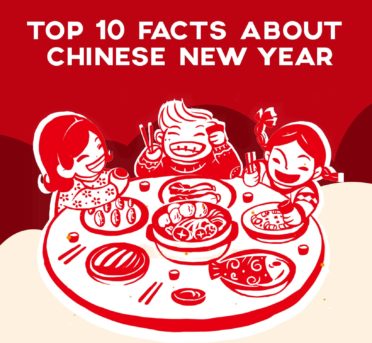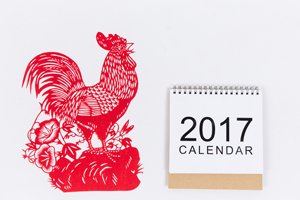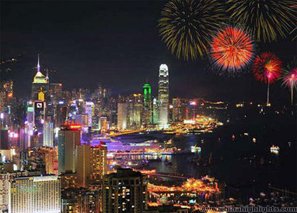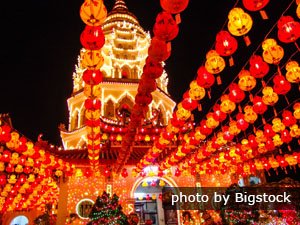
1. The date varies!
The date for Chinese New Year changes each year. It always falls between January 21 and February 20, determined by the Chinese lunar calendar. Chinese New Year 2017 is on Saturday January 28.
- Chinese New Year’s Eve: the day of family reunions
On a Chinese calendar: 除夕 Chúxī /choo-sshee/ ‘getting-rid-of evening’ - Chinese New Year’s Day: the day of (close) family visits and New Year greetings
On a Chinese calendar: 初一 Chūyī /choo-ee/ ‘first 1’
| Chinese Calendar Date | New Year’s Eve | New Year’s Day | Month 1 Day 2 | Month 1 Day 3 | Month 1 Day 4 | Month 1 Day 5 | Month 1 Day 6 |
| 2017 Date | Jan. 27 | Jan. 28 | Jan. 29 | Jan. 30 | Jan. 31 | Feb. 1 | Feb. 2 |
| Day | Friday | Saturday | Sunday | Monday | Tuesday | Wednesday | Thursday |
2. The holiday is oddly called “Spring Festival”.
Though in winter, Chinese call their New Year holidays ‘Spring Festival’ (春节 chūnjié /chwnn-jyeah/), because ‘Start of Spring’ (4–18 February) is the first of the terms in the traditional solar calendar. While wintry weather prevails, ‘Start of Spring’ marks the end of the coldest part of winter, when the Chinese traditionally could look forward to the beginning of spring.
3. Every Chinese New Year starts a new animal’s zodiac year.

4. It is a festival for 1/5 of the world’s population.
It’s China’s winter vacation week, like between Christmas and New Year’s Day other countries. Schools in China get about a month off, and universities even more. China, Hong Kong and Macau, and nine other Asian countries have public holidays.
 Hong Kong blazes with fireworks and lights dance on the buildings.
Hong Kong blazes with fireworks and lights dance on the buildings.- China: 1.3 billion in China get three days of public holiday.
- Indonesia: 250 million people in Indonesia get one day of public holiday.
- Philippines: 100 million get one day of public holiday.
- Vietnam: 90 million people get at least three days of public holidays, but the holidays sometimes extends for an entire week by taking away weekends, as in China.
- South Korea: 50 million people get three days of public holiday.
- Malaysia: 30 million people get two day of public holiday.
- North Korea: 24 million people get three days of public holiday.
- Taiwan: 24 million people get four days of public holiday generally.
- Brunei: One day of public holiday.
- Singapore: Two days of public holiday.
- Hong Kong: Three days of public holidays, extending to four days if the holidays fall on a Sunday.
- Macau: Three days of public holiday, extending to four days if the holidays fall on a Sunday.
5. Billions of red envelopes are exchanged.
These red envelopes with cash are given out from older to younger, from bosses to employees, and from leaders to underlings. It is a special New Year’s bonus.
6. It’s big in London and HK.
500 thousand people converged for Chinese New Year in London’s Chinatown, Trafalgar Square, and central London streets in 2015.
In Hong Kong, a big holiday custom is horse racing: The most popular races of all in the city happens on the third day of the Spring Festival holidays when 100,000 excited fans crowd into Sha Tin Racecourse. The spectators watch a grand opening show, a featured lion dance, and a variety of cultural performances and entertainment.
7. 4% of the world’s population are on the move.
Tens of millions of people travel in other countries too.
8. There is the world’s biggest annual fireworks usage.
No single hour in any other country sees as many tons of fireworks lighted as in China around the midnight beginning Chinese New Year. China produces about 90% of the world’s fireworks!
Fireworks are used to scare evil spirits: Most mainland Chinese believe that the flash and bang of firecrackers and fireworks scare away demons and evil ghosts.
9. The Lantern Festival once ended 16 days of festivities.
 Lanterns for the Lantern Festival
Lanterns for the Lantern FestivalTraditionally, the 16 days from New Year’s Eve until the Lantern Festival each had a special celebration activity.
In the evening of 15th day of the first lunar month, on the night of the full moon, families gather for dinner and go out and see fireworks and light lanterns. Lanterns are put up for decoration, let loose to fly, and floated in rivers.
10. “Xinnian Kuaile” means “Happy New Year”.
Xīnnián kuàilè! (新年快乐). That’s pronounced “sshin-nyen kwhy-luh”, by the way.
- Category (173)
- Accommodation & F&B (81)
- Activities of Households (1)
- Agriculture, Forestry & Fishing (1)
- Arts, Entertainment & Recreation (1)
- Construction (1)
- Education (4)
- Financial & Insurance Takaful (3)
- ICT (2)
- Manufacturing (1)
- Other Classification (29)
- Professional & Technical (1)
- Real Estate (5)
- Wholesale & Retail (43)
- Location (162)
- Bachok (1)
- Guar Chempedak (1)
- Jasin (1)
- Klang (1)
- Kuala Lumpur (1)
- Kuching (145)
- Masai (1)
- Masjid Tanah (1)
- Petaling Jaya (2)
- Saratok (1)
- Serian (1)
- Shah Alam (1)
- Sibu (1)
- Skudai (1)
- Sri Kembangan (1)
- Sungai Buloh (1)
- Ulu Tiram (1)
- State (173)
- Bayan Lepas (1)
- Johor (4)
- Kedah (1)
- Kelantan (1)
- Melaka (2)
- Penang (1)
- Perak (1)
- Sarawak (148)
- Selangor (11)
- WP Kuala Lumpur (4)











